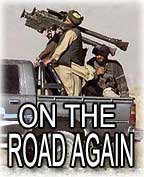Taliban give US occupiers a "New Viet-Nam"
 international |
anti-war / imperialism |
opinion/analysis
international |
anti-war / imperialism |
opinion/analysis  Thursday March 04, 2004 11:34
Thursday March 04, 2004 11:34 by JMcK
by JMcK jimmymac61 at hotmail dot com
jimmymac61 at hotmail dot com
"I play the Terminator, but you guys are the real terminators." Arnold Schwarzenegger, Baghdad, 4 July 2003
The US "Terminators"
US military deaths in Afghanistan ~ 110
US military deaths in Iraq ~ 530
Cumulative Afghan civilian deaths ~ 4,000
Cumulative Iraqi civilian deaths ~ 10,000
Monthly cost of occupation Afghan ($ 950 mn - ) $ 1 bn
Monthly cost of occupation Iraq ($ 3.9 bn - ) $ 4.4 bn
Total forces involved Afghan 44,000
Total forces involved Iraq 222.000
Mullah Omar remains firmly in control of Taliban operations, directing such through a 10-man leadership council that was formed in June 2003. The reorganized rebels appear well-funded and highly motivated. The ample cash served to acquire sophisticated equipment including satellite phones and night-vision goggles.
By mid-2003, the Taliban resistance was making use of remote-controlled devices which increase the effectiveness of the guerrillas. They had set up mobile training camps in the border regions. In later 2003, the Taliban formed four committees - on political, military, cultural and economic affairs - to make their resistance against coalition forces more effective. By August 2003, the reorganized Taliban appointed a military commander for the northern region, (including Faryab), Mullah Mohammad Asim Muttaqi. A couple days later, a convoy of vehicles traveling on a road between Maimana and Almar in Faryab was attacked at night, killing 11 persons.
Taliban spokespersons have publicly elaborated upon their politicoal-military strategy. The group's goal is to tie down the US and NATO (including Irish Army) in Afghanistan and force it to spend huge sums on the occupation, responding to limited though geographically dispersed hit-and-run attacks,. The mujahideen employ the classic pattern of insurgent warfare:
"The enemy attacks, we retreat; the enemy camps, we raid; the enemy tires, we attack. When the Russians came here we fought to save our liberty and independence."
The US would gradually be sapped by such a slow, costly and grinding conflict and would abandon Afghanistan after 2 or 3 years. The Taliban have increasingly directed their attacks precisely at the 'softer' proxy forces, killing 400-500 Afghan troops between June 1, 2003 and January 1, 2004, while only killing less than ten American soldiers. For example, such sporadic, small unit attacks killed nine US soldiers in the Shkin area of Paktika alone in 2003.
The heavy-handed US search-and-destroy forays over time swell the ranks of supporters, as the battle for Afghan hearts and minds tipped in favor of the Taliban. US aerial 'decapitation raids' frequently devastate small villages and families. In January 2004, two US raids killed 15 children and not a single Taliban was either captured or killed. The reality of living daily in fear is captured in the words of a young girl in Loi Karez, Zabul
Feb. 12/13, 2004 - Khost - 21 rockets fired at Camp Salerno on Khost airport
Feb. 13, 2004 - Khost -Remote-controlled mine kills 1 policeman and a shopkeeper
Feb. 11, 2004 - Khost - Khost deputy intelligence chief killed
Feb. 13, 2004 - Ghazni - mine under Humvee killing 1 and injuring 9 US troops
Feb. 14, 2004 - Faryab - Taliban attacked convoy killing 4 Afghan deminers
The prospect is of war without end, elusive guerrilla fighters, persisting violence, use of ineffective local proxies, corruption and impoverishment. The non-stop mantra in the mainstream corporate media about "remnants" of the Taliban being at the source of this conflict, misrepresents the depth and organization of resistance to the US occupation and is part of the US propaganda war. About all the US occupation force could report on optimistically was its new 20-house military headquarters opened on February 3, 2004 in the posh Wazir Akbar Khan area of Kabul. That evening, two rockets slammed into Kabul.
Afghanistan is now referred to as a "humanitarian disaster" with more social and political problems than when the Taliban had taken over from warlords and criminals
